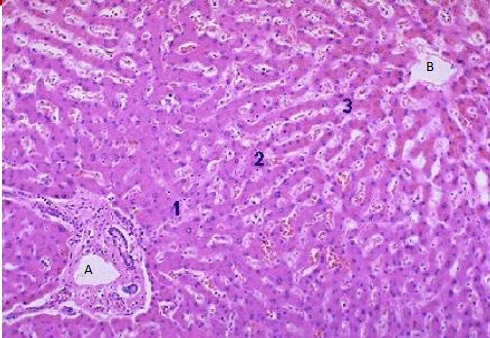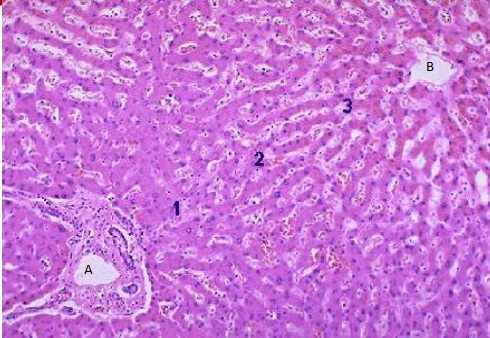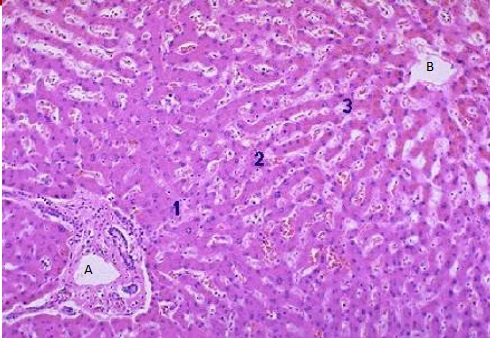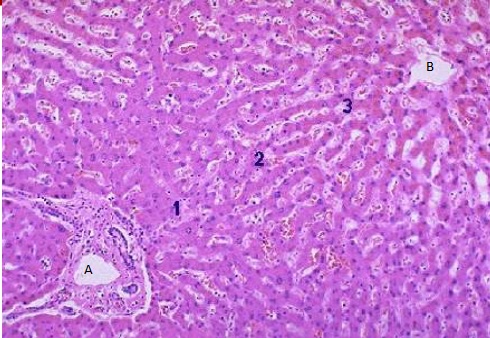Liver Quiz!

I made it easier this time! Good luck on the summative :)
- 1.
Blood flows through the liver:
- A.
A, 1, 2, 3, B
- B.
B, 3, 2, 1, A
- C.
A, 1, 2, 1, A
Correct Answer
A. A, 1, 2, 3, BExplanation
Blood flows through the liver in a specific sequence. First, it enters the liver through the hepatic artery (1), which supplies oxygenated blood to the liver. Then, it passes through the liver sinusoids (2), where nutrients, toxins, and waste products are exchanged. Next, the blood flows into the hepatic vein (3), which carries the deoxygenated blood out of the liver and back to the heart. Finally, the blood leaves the liver and continues its circulation throughout the body (B). This sequence ensures that the liver can perform its vital functions, such as detoxification and metabolism.Rate this question:
-
- 2.
A is:
- A.
Portal vein
- B.
Central vein
- C.
Hepatic artery
- D.
Bile duct
Correct Answer
A. Portal veinExplanation
The portal vein is the correct answer because it is responsible for carrying blood from the gastrointestinal tract, spleen, and pancreas to the liver. This blood is rich in nutrients and other substances that need to be processed by the liver. The portal vein branches out within the liver and eventually connects to the central vein, which then drains into the hepatic vein and returns blood to the heart. The hepatic artery supplies oxygenated blood to the liver, while the bile duct carries bile produced by the liver to the gallbladder and small intestine.Rate this question:
-
- 3.
B is:
- A.
Portal vein
- B.
Central vein
- C.
Hepatic artery
- D.
Bile duct
Correct Answer
B. Central veinExplanation
The central vein is the correct answer because it is a blood vessel that is located in the center of the liver lobule. It receives blood from the hepatic sinusoids, which are small blood vessels that carry oxygenated blood from the hepatic artery and nutrient-rich blood from the portal vein. The central vein then carries this blood out of the liver and eventually merges with other central veins to form the hepatic veins, which empty into the inferior vena cava.Rate this question:
-
- 4.
Bile flows:
- A.
In the same direction as the blood
- B.
In the opposite direction as the blood
- C.
Into the central vein
Correct Answer
B. In the opposite direction as the bloodExplanation
Bile flows in the opposite direction as the blood because it is produced by the liver and stored in the gallbladder. It is then released into the small intestine to aid in the digestion and absorption of fats. The flow of bile is regulated by the sphincter of Oddi, which controls the release of bile into the small intestine. Since the blood flows towards the liver for filtration and processing, the bile flows in the opposite direction to reach the small intestine.Rate this question:
-
- 5.
The portal vein supplies:
- A.
20% of the blood to the liver
- B.
45% of the blood to the liver
- C.
80% of the blood to the liver
- D.
90% of the blood to the liver
Correct Answer
C. 80% of the blood to the liverExplanation
The portal vein supplies 80% of the blood to the liver. This is because the portal vein is responsible for carrying nutrient-rich blood from the gastrointestinal tract, spleen, and pancreas to the liver. This blood contains nutrients and other substances that are absorbed from the digestive system and need to be processed by the liver. Therefore, the portal vein plays a crucial role in delivering a significant majority of the blood supply to the liver for its various functions, including detoxification, metabolism, and storage of nutrients.Rate this question:
-
- 6.
Pruritis is:
- A.
A sign of cholestatic liver disease
- B.
Itchiness
- C.
Caused by thrombocytopenia
- D.
A and b
Correct Answer
D. A and bExplanation
Pruritis is a symptom of cholestatic liver disease, which is characterized by impaired bile flow from the liver. It is also a term used to describe itchiness. Therefore, the correct answer is a and b, as pruritis can be a sign of cholestatic liver disease and is also associated with itchiness.Rate this question:
-
- 7.
Which of the following is NOT a complication of cirrhosis?
- A.
Variceal bleeding
- B.
Hematemesis/melena
- C.
Palmar erythema
- D.
Ascites and lower leg edema
- E.
Confusion/encephalopathy
Correct Answer
C. Palmar erythemaExplanation
Palmar erythema is a common physical finding in patients with cirrhosis, caused by elevated estrogen levels and increased blood flow to the skin. It is characterized by redness and warmth in the palms of the hands. Variceal bleeding, hematemesis/melena, ascites and lower leg edema, and confusion/encephalopathy are all complications commonly associated with cirrhosis. Therefore, palmar erythema is not a complication of cirrhosis.Rate this question:
-
- 8.
35-year-old male patient with a two-week history of N/V and progressive jaundice had the following test results: ALT 800 [1-40], AST 700 [8-32], ALP 95 [30-115], Bili 100 (direct 80), INR 1.5 [0.8-1], Creatinine 150 [60-120]. What would be on your DDx? (check all that apply)
- A.
Viral hepatitis
- B.
ETOH
- C.
Drugs/toxins
- D.
NAFLD
- E.
PBC, PSC
- F.
Biliary stricture
- G.
Ischemia
- H.
Pregnancy
- I.
Wilson's disease
- J.
Malignant infiltration
Correct Answer(s)
A. Viral hepatitis
C. Drugs/toxins
G. Ischemia
I. Wilson's disease
J. Malignant infiltrationExplanation
see the super-duper scheme for liver tests... in the cases of PBC, PSC, and biliary stricture, one would see elevated ALP.
ETOH is unlikely since the ALT/AST ratio isn't 2:1 and ALT is greater than 300.
NAFLD is unlikely to produce such high levels.
and he's a man...not likely to be pregnant.Rate this question:
-
- 9.
You ran some viral serology on this guy and this is what you get: anti-HAV antibody (total) positive, HBsAg positive, anti-HBs antibody negative, anti-HCV antibody negative. What does this MEAN?
- A.
Ongoing HAV and HBV infections
- B.
HCV and HBV immunity
- C.
Ongoing HBV infection with HAV immunity
Correct Answer
C. Ongoing HBV infection with HAV immunityExplanation
The given serology results indicate that the person has a positive result for anti-HAV antibody, indicating immunity to hepatitis A virus (HAV). They also have a positive result for HBsAg, indicating an ongoing hepatitis B virus (HBV) infection. The negative results for anti-HBs antibody and anti-HCV antibody suggest no immunity to hepatitis B or hepatitis C viruses. Therefore, the interpretation is that the person has an ongoing HBV infection but is immune to HAV.Rate this question:
-
- 10.
So you ordered some MORE tests on this guy (has he run out of blood yet?) This is what you get: anti-HAV IgM positive, anti-HBc total positive, anti-HBc IgM negative, HBVDNA negative, anti-HDV negative. What does THIS mean?
- A.
He's got a chronic HAV infection
- B.
He's got an acute HBV infection
- C.
His HAV immunity was from vaccination
- D.
He's got a chronic HBV infection
Correct Answer
D. He's got a chronic HBV infectionExplanation
IgM is a marker of acuity. Therefore, he has an acute HAV infection but a chronic HBV infection.Rate this question:
-
- 11.
How could he have picked up this HBV virus? (check all that apply)
- A.
Fecal-oral
- B.
Parenteral (blood products or IVDU)
- C.
Sexual
- D.
Perinatal
Correct Answer(s)
B. Parenteral (blood products or IVDU)
C. Sexual
D. PerinatalExplanation
Hep A is fecal-oral
Hep C is primarily parenteral
Hep B is parenteral/sexual/perinatal (particularly in Asia/Africa)Rate this question:
-
- 12.
HBV Treatment:patients who are HBeAg negative require life-long treatment
- A.
True
- B.
False
Correct Answer
A. TrueExplanation
true because you can't monitor seroconversion.
Treatment includes:
Nucleoside analogues (LAM, ENT, LdT)
Nucleotide analogues (ADF, TNF)
interferon or PEG-IFNRate this question:
-
- 13.
There is a vaccine for HCV
- A.
True
- B.
False
Correct Answer
B. FalseExplanation
The statement "There is a vaccine for HCV" is false. As of now, there is no approved vaccine available for Hepatitis C Virus (HCV). While there are vaccines for other types of hepatitis, such as Hepatitis A and Hepatitis B, there is no vaccine specifically for HCV. The primary mode of prevention for HCV is through avoiding high-risk behaviors such as sharing needles or having unprotected sex with an infected person.Rate this question:
-
- 14.
You're a GP, and your patient, a 58-year old woman who suffers from rheumatoid arthritis comes in jaundiced with fatigue and ITCHINESS!What do you do?
- A.
Gallstones! do an abdominal ultrasound!
- B.
PBC! bring on the URSO! (after you test for AMA and IgM)
- C.
Autoimmune hepatitis! Do a biopsy!
- D.
Buy some stock in GOLD-BOND anti-itch lotion
Correct Answer
B. PBC! bring on the URSO! (after you test for AMA and IgM)Explanation
You could still do an abdominal ultrasound, but considering she wasn't complaining of pain, I'd say gallstones would be lower on your DDx.
It could still be autoimmune hepatitis, which you should be concerned about since it CAN lead to ALF, but biopsy shouldn't be your first test (that's painful and expensive!)Rate this question:
-
- 15.
You're a GP (well, 50% chance you end up a GP, just go with me on this one) and you've got a patient who comes in and you're like "did you just get back from vacation?" and he's like "No, in fact, since it's Canadian winter I haven't seen the sun in MONTHS!"He complains of joint pain and his routine labwork shows that he's pre-diabetic. What do you do?
- A.
Tell him to fix his diet before he becomes ginormously obese
- B.
Tell him to stop going to tanning salons, skin cancer is not fun!
- C.
Test his transferrin saturation
- D.
Test for AMA, ASMA
Correct Answer
C. Test his transferrin saturationExplanation
Hemochromatosis leaves iron deposits in the skin, leaving a "tanned" appearance. Other symptoms include diabetes, arthritis, CHF, arrhythmias, cirrhosis and HCC.
High ferritin or high transferrin saturation will support this diagnosis; treatment is phlebotomy until the ferritin is below 50.Rate this question:
-
- 16.
Your favourite TV show is HOUSE, MD.On the show, Dr. House's best friend is diagnosed with an autosomal recessive disorder in which he has impaired biliary excretion of copper.What is the name of this disease?
- A.
Cuddy's disease
- B.
Chase's disease
- C.
Wilson's disease
- D.
Foreman's disease
Correct Answer
C. Wilson's diseaseExplanation
Wilson's disease is the correct answer. In the TV show HOUSE, MD, Dr. House's best friend, Dr. James Wilson, is diagnosed with Wilson's disease. This disease is an autosomal recessive disorder that causes impaired biliary excretion of copper. It results in the accumulation of copper in various organs, particularly the liver and brain, leading to symptoms such as liver dysfunction, neurological problems, and psychiatric disturbances.Rate this question:
-
- 17.
In which phenotype is A1AT deficiency most likely to be harmful?
- A.
PiSS
- B.
PiMZ
- C.
PiSZ
- D.
PiZZ
Correct Answer
D. PiZZExplanation
PiZZ also causes neonatal jaundice, 1:3500 birthsRate this question:
-
- 18.
58-year old Joanna has the following liver test results: ALT 35, AST 20, ALP 445, Bili 24.Her total cholesterol is high, her viral serology was negative for infection. She had a previous fractured wrist 4 months ago.What is your next test?
- A.
Abdominal ultrasound
- B.
GGT
- C.
INR
- D.
AMA
- E.
Bone density scan
Correct Answer
B. GGTExplanation
a high GGT would indicate a cholestatic problem, whereas a low GGT would indicate that the high levels of ALP are coming from the bone.Rate this question:
-
- 19.
Name one risk factor for gallstones (there are 6)
Correct Answer
female
fertile
fat
family
fasting pharmacologyExplanation
The correct answer is female, fertile, fat, family, fasting. These are all risk factors for developing gallstones. Being female and fertile increases the risk due to hormonal changes. Being overweight or obese (fat) also increases the risk. Having a family history of gallstones is another risk factor. Fasting or rapid weight loss can also contribute to the formation of gallstones. However, pharmacology is not a risk factor for gallstones.Rate this question:
- 20.
In alcoholics, you would expect to see (select all that apply)
- A.
Increased IgA
- B.
AST>ALT
- C.
Increased likelihood of IBD
- D.
Increased sensitivity to acetaminophen toxicity
- E.
Fist-pumping
- F.
Steatosis
Correct Answer(s)
A. Increased IgA
B. AST>ALT
D. Increased sensitivity to acetaminophen toxicity
F. SteatosisExplanation
In alcoholics, increased IgA levels are expected because chronic alcohol consumption can stimulate the production of immunoglobulin A (IgA) in the body. AST>ALT indicates that the levels of aspartate aminotransferase (AST) are higher than alanine aminotransferase (ALT), which is commonly seen in alcoholic liver disease. Increased sensitivity to acetaminophen toxicity is observed in alcoholics because alcohol can induce the production of enzymes that metabolize acetaminophen into toxic byproducts. Steatosis, or fatty liver, is also commonly seen in alcoholics due to the accumulation of fat in the liver cells. Fist-pumping is not a relevant finding in alcoholics.Rate this question:
-
- 21.
The CAGE questionnaire stands for...
Correct Answer(s)
cut down, annoyed, guilty, eye-openerExplanation
The CAGE questionnaire is a screening tool used to identify potential alcohol dependency in individuals. Each letter in the acronym represents a question related to alcohol consumption. "Cut down" refers to whether the person has ever felt the need to cut down on their drinking. "Annoyed" asks if others have expressed annoyance or criticism about their drinking habits. "Guilty" inquires if the person feels guilty about their drinking. Lastly, "eye-opener" refers to whether the person has ever felt the need to drink first thing in the morning to steady their nerves or get rid of a hangover.Rate this question:
- 22.
A high IgG level may indicate...
- A.
Autoimmune hepatitis
- B.
Alcohol
- C.
PBC
Correct Answer
A. Autoimmune hepatitisExplanation
A high IgG level may indicate autoimmune hepatitis because this condition is characterized by the immune system mistakenly attacking the liver. IgG is a type of antibody produced by the immune system, and elevated levels can be a sign of an autoimmune response. In autoimmune hepatitis, the immune system targets the liver cells, leading to inflammation and damage. Therefore, a high IgG level can be a useful marker for diagnosing autoimmune hepatitis.Rate this question:
-
- 23.
A high IgA level would indicate....
- A.
Autoimmune hepatitis
- B.
Alcohol
- C.
PBC
Correct Answer
B. AlcoholExplanation
A high IgA level would indicate alcohol consumption. IgA is an antibody that is produced in response to infections and is also found in high levels in individuals who consume excessive amounts of alcohol. This can be used as a marker to assess alcohol consumption and its associated health risks.Rate this question:
-
- 24.
A high IgM level would indicate...
- A.
Autoimmune hepatitis
- B.
Alcohol
- C.
PBC
Correct Answer
C. PBCExplanation
A high IgM level would indicate primary biliary cholangitis (PBC). IgM is an immunoglobulin that is produced in response to an infection or inflammation in the body. In PBC, the immune system mistakenly attacks the bile ducts in the liver, leading to inflammation and damage. This immune response triggers the production of IgM antibodies. Therefore, a high IgM level can be a marker of PBC. It is important to note that a high IgM level alone cannot definitively diagnose PBC, and further testing and evaluation are necessary for a proper diagnosis.Rate this question:
-
- 25.
If you suspect Wilson's disease and you test for ceruloplasmin and it comes back low, what is your next step?
- A.
IgG
- B.
24h urine Cu
- C.
Fasting lipids
- D.
AMA
- E.
Watch more HOUSE MD
Correct Answer
B. 24h urine CuExplanation
If you suspect Wilson's disease and the ceruloplasmin test comes back low, the next step would be to perform a 24-hour urine copper test. Wilson's disease is a genetic disorder that causes copper to accumulate in the body, leading to various symptoms and organ damage. Measuring the amount of copper excreted in a 24-hour urine sample can help confirm the diagnosis. Other tests, such as liver function tests and genetic testing, may also be performed to further evaluate the condition.Rate this question:
-
- 26.
SO you do all the normal liver tests and everything comes back normal. What is another test that you might want to do?
- A.
Abdominal ultrasound
- B.
ERCP
- C.
TSH
Correct Answer
C. TSHExplanation
One possible explanation for selecting TSH as the additional test to be done is that TSH stands for Thyroid Stimulating Hormone, which is produced by the pituitary gland and regulates the thyroid gland's production of thyroid hormones. Since the question mentions that all the normal liver tests came back normal, it suggests that the liver might not be the cause of the issue. Therefore, checking the thyroid function through a TSH test could be a relevant next step in investigating the underlying cause of the symptoms.Rate this question:
-
- 27.
Name a complication of cirrhosis (4)
Correct Answer
varices
ascites
encephalopathy
confusion
cancer or HCCExplanation
The given answer lists four complications of cirrhosis: varices, ascites, encephalopathy, and confusion. These are all common complications that can occur in individuals with cirrhosis. Varices are enlarged veins in the esophagus or stomach that can rupture and cause life-threatening bleeding. Ascites refers to the accumulation of fluid in the abdomen, leading to abdominal swelling. Encephalopathy refers to brain dysfunction that can cause confusion, memory problems, and changes in behavior. Confusion is a symptom that can occur as a result of encephalopathy. Finally, cancer or hepatocellular carcinoma (HCC) is a potential complication of cirrhosis due to the increased risk of liver cancer in individuals with cirrhosis.Rate this question:
- 28.
What is the treatment/management of ascites (due to portal hypertension)?
Correct Answer
NO SOUP FOR YOU
restrict Na/sodium - 29.
Which of the following are indications to treat HBV infection? (select all that apply)
- A.
Chronic infection
- B.
Active viral replication
- C.
Hepatic injury
- D.
Pregnancy and high viral load
- E.
Chemo & immunosuppression
- F.
Severe acute HBV prior to LT
Correct Answer(s)
A. Chronic infection
B. Active viral replication
C. Hepatic injury
D. Pregnancy and high viral load
E. Chemo & immunosuppression
F. Severe acute HBV prior to LTExplanation
yes, it's all of them. HA!Rate this question:
-
Quiz Review Timeline +
Our quizzes are rigorously reviewed, monitored and continuously updated by our expert board to maintain accuracy, relevance, and timeliness.
-
Current Version
-
Mar 21, 2023Quiz Edited by
ProProfs Editorial Team -
Oct 17, 2010Quiz Created by
Cimanim
- Abdomen Quizzes
- Addiction Quizzes
- Aging Quizzes
- Arthritis Quizzes
- Beauty Quizzes
- Body Quizzes
- Bone Quizzes
- Brain Quizzes
- Child Health Quizzes
- Dermatology Quizzes
- Digestive System Quizzes
- Disease Quizzes
- Fertility Quizzes
- First Aid Quizzes
- Hair care Quizzes
- Health And Nutrition Quizzes
- Health And Wellness Quizzes
- Health Policy Quizzes
- Health Psychology Quizzes
- Health Worldwide Quizzes
- Hearing Quizzes
- Heart Quizzes
- Hospital Quizzes
- Illness Quizzes
- Injury Quizzes
- Medical Quizzes
- Mental Health Quizzes
- Nose Quizzes
- Nutrition Quizzes
- Obesity Quizzes
- Ophthalmology Quizzes
- Patient Quizzes
- Patient care Quizzes
- Pharmacy Quizzes
- Pregnancy Quizzes
- Puberty Quizzes
- Public Health Quizzes
- Respiratory System Quizzes
- Sleep Quizzes
- Stress Quizzes
- Surgery Quizzes
- Surgical Instruments Quizzes
- Throat Quizzes
- Weight Quizzes
- Wellness Quizzes
 Back to top
Back to top






